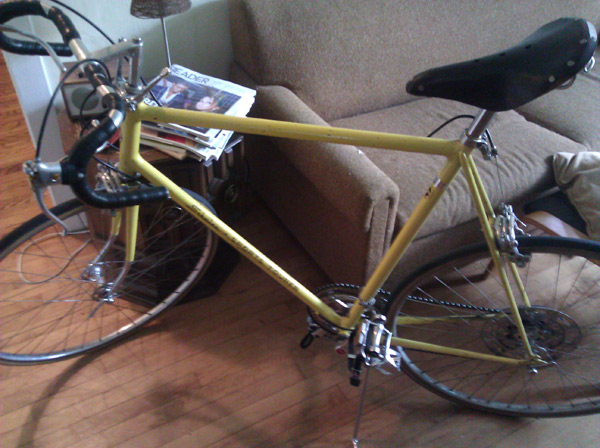So a friend of mine moved and passed along his bike to me. Not knowing that much about the finer details of bike history, I thought it looked at first glance like a respectable beater with a nice Brooks saddle, so I figured I'd give it a shot.

But it turns out that the Schwinn Sports Tourer of a certain vintage is a relatively sought-after set of wheels, thanks to the highly skilled manufacturers of the old Chicago Schwinn factory, in which a time-consuming, now-rare process called fillet-brazing was used to build the not-quite-top-of-the-line* Sports Tourers. As Mike Rother writes in his history of fillet-brazed Schwinns, the company moved from its focus on heavy kids' bikes thanks to the success of lightweight European bikes:
Brazing is a joining process employing a filler metal, like brass, that melts below the melting temperature of the parent metal workpiece. Fillet brazing involves building up brass filler metal in a smooth "fillet" around joints.
In this method of bicycle frame construction, "mitering" or cutting the tube ends so that they fit together precisely is critical so that capillary action will draw the molten filler into gaps for a strong joint. The extra thickness of the fillet also provides strength, and its smooth contour distributes stresses evenly. (For additional strength Schwinn also brazed steel sleeves into the interior of its frame tubes at the joints.)
Fillet-brazed bicycle frames are strong and have a neat and clean appearance, but they are uncommon because of the additional craftsmanship required. Lugged bicycle frames, for example, are now manufactured by automated machines. Custom framebuilders still provide fillet-brazed construction, and tandem framesets were often fillet-brazed when lugs to fit their frame angles were not available.
The company cut corners with heavy parts, and, Rother argues, failed to adequately advertise the fillet-brazing method, so it passed into obscurity for all but hardcore bike connoisseurs. They weren't cheap then—mine would have cost the equivalent of about $750 in the early 1970s—but today fillet-brazed frames will run you a couple thousand dollars.
I couldn't find my wrench last night, so I don't know yet whether it's too big. I hope not, because I like having a historical connection to the old Chicago Schwinn handbuild shop.
* The top-of-the-line Schwinn was the Paramount, developed by Belgian immigrant Emil Wastyn and founder of what's now Oscar Wastyn Cycles on Fullerton.



